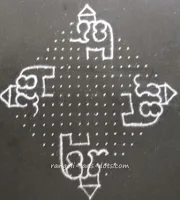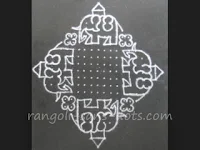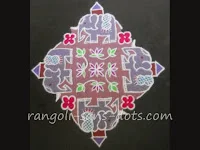The elephant kolam design is a popular kolam with dots found in public domain. It is also a popular kolam in our family.
Just as we have "family song" in our movies, there are some rangolis with dots that have been popular in our family for decades.
This is one of them.
Another using
birds has been shown in an earlier kolam here in this blog. More will follow in the future.
The dot pattern for this rangoli is 21 to 1 (ner pulli).
First draw all the elephants one by one. Then the central floral design is drawn, and the remaining dots are filled with floral designs.
Finally, the colours are filled, and remaining gaps are filled with some colour, brown in this case. Free hand decorations of the elephant are done
to complete the kolam with 21 dots this can be classified as a big kolam with dots.
There are many more kolam that need a dot pattern using 20 and 25 dots. Since drawing them by the traditional method is time consuming,
I will update this post as and when I add more rangoli designs of this type to my collection.
The elephant-rangoli designs is a rangoli with 21 to 1 dot intermediate step are shown below.
One image is with only the elephants and canopied seat (called howdah or ambari ).
The gaps between two elephants is filled with a four-petal floral design and the tusk as shown. That leaves only the dots at the centre.
I have filled it with a common floral petal design which with colours filled is available in simple floral patterns.
(Simple kolam designs can be used independently as a kolam or as a part of a bigger kolam ).
The first step shows only the four elephants drawn on four sides with the canopied seat and caparison ( a decorative cloth on the back) .
In the second step I have added the tusk(s) and floral patterns between the elephants.
Big chukki rangoli for festivals step by step
Dodda rangoli designs
Dodda rangoli galu ideas for
New Year , Sankranthi and other festivals
Simple big rangoli pattern
Many viewers have asked about the rangoli powder I use. I add one part rice flour to three parts of white rangoli powder (sieve to remove coarse particles) and mix well. I use the mixture for drawing rangoli. This mixture gives us the benefits of rice flour and kola podi. I have shared this several times on social media already. Many have thanked me profusely stating that this tip is very useful to them. I would like to post here too for those who are not aware.
It is believed that on internet one should not share knowledge for free :) I do not believe it that idea. For me this beautiful and simple art of our country should be sustained by generations to come. I am doing my bit be sharing this rangoli tip as also the kolam designs. It makes me happy. I feel like the proverbial squirrel in Ramayana.
Rangoli tip - Should draw the kolam standing from one side or go around the design to draw the fractals or repeated patterns. For a big kolam for competition like this one in the post we have to draw from all sides. For small and medium designs, I prefer to draw from one side only. It can be challenging to visualise the patterns and draw them from one side, but I love it and am comfortable with it. Also, add to it the fact that I place a compact dot grid. There is no hard and fast rule. If we are comfortable drawing from all sides, we should do it that way.





Comments